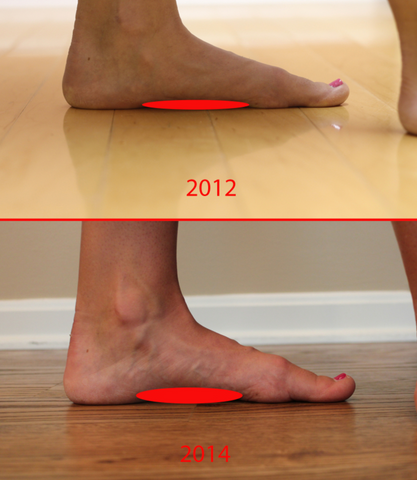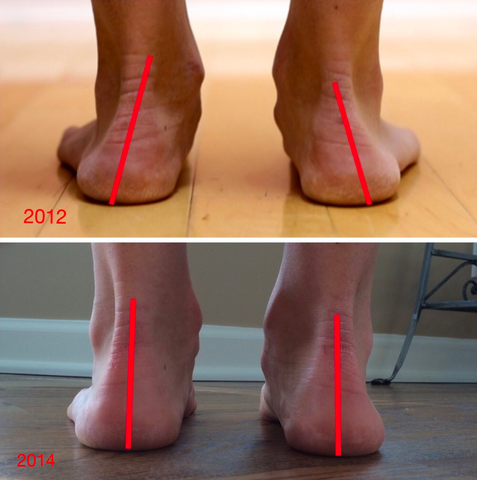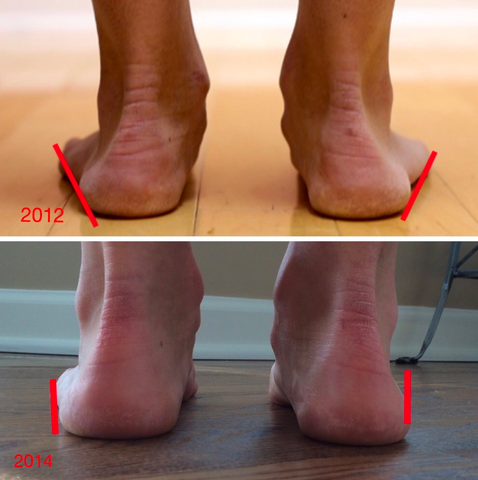Where traditional sneakers and convention running shoes tilt and alter the foot's natural gait through elevated heels, minimalist barefoot shoes reconnect you with your true sense of motion through zero drop design. But what makes a shoe "zero drop" and how do zero drop shoes strengthen your steps?
What Does Zero Drop Mean?
When referring to a shoe’s “drop”, it indicates the difference in thickness of the sole under the toes versus under the heel. Most traditional running shoes have a drop of between 6 and 12 millimeters. The result of this difference is that the heel is raised by the amount of drop indicated. As we have discussed in previous blog posts, raising the heel when walking or running greatly increases the impact and stress placed on the forefoot and toes, which is why we make zero drop shoes that allow feet to stand naturally and evenly from toe to heel.
Why Zero Drop Shoes Matter
By contrast, zero drop shoes have the same thickness of sole under the forefoot and the heel. This results in your foot being kept level while standing or moving. This encourages a more natural mid-foot or forefoot strike and engagement of the foot.

The design principle of a barefoot minimalist shoe is simple: let your feet do what they were made to do. Your feet evolved to walk, stand and run without the use of heavily-designed footwear that alters the foot’s natural state by using foam wedges and similar structures. By allowing your feet to function as designed, they also allow your joints and leg muscles to properly align and function naturally.
Benefits of Zero Drop Shoes
They encourage a low-impact gait.
They provide a more natural feel.
They are lighter.
They disperse the impact.
By reducing the impact on your knees by spreading the forces throughout the leg and allowing your feet to land and function as designed. They effectively turn your calves into shock absorbers which lessens the risk of injury.
They strengthen your feet.
Studies have shown that flat soles increase your foot’s strength as it does not rely on the artificial support of a modern shoe. This increased strength can improve alignment, stability, stamina, and help ward off injuries.
They reduce the risk of injury.
While studies are still being conducted in this area, initial findings suggest they reduce the risk of injury. This is due to the shoe’s ability to allow the foot, leg and back to function as designed, spreading the forces evenly amongst them. The elevated heel of most modern shoes alters the natural stance on the body, limiting the body’s natural ability to absorb impact due to misalignment of joint and muscle interactions.
The Impact of Wearing Zero Drop Shoes
A 34-year-old woman was part of a two-year study to measure the difference made by switching from her then current running shoe and custom orthotic combination to a flat shoe without an orthotic. After completing an eight-week transition period that allowed her foot to adapt to the new shoes, she continued with her training as normal, utilizing the zero drop shoes.
After two years the results were not only dramatic, but can be observed.

The added strength in her foot raised her arch, which increased the foot’s natural shock absorption and improved the alignment of her lower body.

The added strength and increased arch height brought her feet back into proper alignment with her ankles and lower leg. This allows the body to spread the impact forces properly, and move as designed, which reduces the risk of injury.

The increased foot strength and proper alignment brought her feet from being pointed outward, or so-called duck-footed, to a more natural forward-facing alignment. This reduces stress, increases efficiency and reduces the risk of injury.
“Zero drop shoes can make it easier to run with more efficient form,” says Jay Dicharry, MPT, director of the SPEED Clinic at the University of Virginia’s Center for Endurance Sport. “But,” he continues, “it’s still possible to run efficiently in shoes with slightly raised heels.”
How To Transition To a Zero Drop Shoe
1. Acclimate your feet.
- Practice walking barefoot or in your new minimalist shoes for short stints every other day.
- Slowly increase the distance or time using the new shoes.
- Then slowly increase the frequency of use of the new shoes.
- Gently stretch your calf and arch muscles before and after use.
2. If you plan to run: practice your running mechanics.
- Practice landing on your midfoot versus your heel. Don't be afraid to let the heel contact the ground—but concentrate on striking with the midfoot first.
- Don't over stride. For zero drop running, use short strides and a quick cadence with your midfoot strike. Run with a metronome app and aim for 180 strides per minute; it is very difficult to heel strike at that stride rate.
- Your landings should feel gentle, relaxed and quiet. Avoid letting the soles of your feet slap against the ground.
3. If you plan to run: gradually increase distance.
- Start slowly and don't do too much too soon.
- Try using the 10 percent rule—don’t increase your weekly mileage (in barefoot/minimalist footwear) by more than 10 percent each week.
4. Overall: use caution.
- The lower the heel-to-toe drop on your shoes, the harder your Achilles tendon will need to work. Be especially careful with easing into longer miles in zero drop shoes.
- Listen to your body. If you feel any pain, stop. If you have suffered injuries in the past, you know already how important it is to listen to your feet. The transition will be different for everyone, and that is okay.
- If you take four to six weeks to slowly transition your feet to the new shoes, there is no reason you shouldn’t be on your way to a set of stronger, healthier feet.
For more helpful guidance and reading material on making the switch to barefoot footwear, check out Whole Body Barefoot by biomechanist Katy Bowman. She lays out the issues created by conventional shoes and artificial environments, and describes in detail the steps necessary to transition to more natural footwear safely and effectively.

With over 20 exercises (with photos and step-by-step instructions) this book is a must-have for anyone hoping to restore lost foot function and improve their health…naturally!
You can pick up your copy here.
Zero Drop Footwear Trusts Your Feet
In addition to the wonderful feeling of freedom zero drop shoes provide, there is documented evidence that demonstrates the health benefits of allowing the foot to function as it was intended. All of SOM’s low tops, mid tops, and trainers have a zero drop profile.
To learn more about the steps you can take when adjusting from traditional footwear to SOM shoes, please check out our blog, New to Barefoot Shoes?




Hello Lauri,
You most certainly can wear both types of shoes. When you’re only wearing them for a few hours at a time there isn’t much of a transition. Now if you want to convert completely you will need to transition and at first it may be a little uncomfortable converting to minimalist shoes. We hear about some slight discomfort from customers who are transitioning, you can find more information here in this article by Dr. Ray a sports’ podiatrist…
https://www.correcttoes.com/foot-help/transitioning-from-conventional-to-minimalist-shoes/
Thanks,
Crystal
I’m looking to just walk in the shoes. No running. Is there still a transition? Can you were regular shoes when not walking?